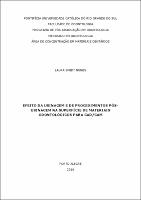| Compartilhe o registro |


|
Use este identificador para citar ou linkar para este item:
https://tede2.pucrs.br/tede2/handle/tede/6833Registro completo de metadados
| Campo DC | Valor | Idioma |
|---|---|---|
| dc.creator | Nunes, Laura Smidt | - |
| dc.creator.Lattes | http://buscatextual.cnpq.br/buscatextual/visualizacv.do?id=K4304850P9 | por |
| dc.contributor.advisor1 | Mota, Eduardo Gonçalves | - |
| dc.contributor.advisor1Lattes | http://buscatextual.cnpq.br/buscatextual/visualizacv.do?id=K4705811J8 | por |
| dc.date.accessioned | 2016-07-14T16:57:14Z | - |
| dc.date.issued | 2016-03-08 | - |
| dc.identifier.uri | http://tede2.pucrs.br/tede2/handle/tede/6833 | - |
| dc.description.resumo | O objetivo do estudo foi avaliar a rugosidade superficial e analisar a topografia de superfície de cinco diferentes cerâmicas, um compósito resinoso e dois acrílicos para CAD/CAM após usinagem e procedimentos pós-usinagem. Blocos de Mark II, IPS Empress CAD, IPS e.max CAD, Enamic, Lava Ultimate, Suprinity, CAD-Temp e CAD- Waxx foram usinados no sistema CEREC MCXL. A rugosidade superficial (Ra; μm) foi aferida antes e após os procedimentos de usinagem, polimento e glaze (quando indicado) seguidos de análises em MEV e MFA. Os resultados foram submetidos a testes estatísticos (teste one-way ANOVA para medidas repetidas e Tukey HSD e ANOVA one-way também com Post-Hoc Tukey, respectivamente) com nível de significância de 5% (α=0,05). A etapa de fresagem aumentou significativamente a rugosidade superficial em todos os materiais testados (p<0,05). O polimento foi capaz de reduzir a rugosidade gerada pela usinagem, sendo necessária a etapa de glazeamento apenas para cerâmicas parcialmente cristalizadas (IPS e.max CAD e Suprinity). Nos demais materiais (Mark II, IPS Empress CAD, Lava Ultimate, Enamic, CAD-Temp e CAD-Waxx) o polimento mecânico foi suficiente para atingir valores de rugosidade superficial similares a lisura dos blocos provenientes diretamente dos fabricantes. O estudo sugere que a etapa de glaze pode ser suprimida nos materiais já provenientes do fabricante completamente cristalizados e/ou polimerizados, nestes não possuindo diferença estatisticamente significativa quando apenas é realizado polimento mecânico. | por |
| dc.description.abstract | The aim of the study was to evaluate the surface roughness and analyze the surface topography of five different ceramics, a resin composite and two polymers for CAD/CAM after milling and post milling procedures. Blocks of Mark II, IPS Empress CAD, IPS e.max CAD, Enamic, Lava Ultimate, Suprinity, CAD-Temp and CAD-Waxx were milled in CEREC MCXL system. The surface roughness (Ra; μm) was measured before and after millig procedures, polishing and glaze (when indicated) followed by analysis by SEM and AFM. The results were subjected to statistical tests (one-way ANOVA for repeated measures and Tukey HSD and one-way ANOVA also with Post-Hoc Tukey, respectively) with a significance level of 5% (α=0.05). The milling step significantly increased surface roughness in all tested materials (p<0.05). Mechanical polishing was able to reduce the roughness generated by grinding, requiring the glazing step only in partially crystallized ceramic (IPS e.max CAD and Suprinity). In other materials (Mark II, IPS Empress CAD, Lava Ultimate, Enamic, CAD- Temp and CAD-Waxx) mechanical polishing was enough to achieve similar surface roughness values of the smoothness of the blocks directly from manufacturers. The study suggests that the glaze step can be suppressed in materials completely crystallized and/or polymerized by the manufacturer, these having no statistically significant difference when it's just done mechanical polishing. | eng |
| dc.description.provenance | Submitted by Setor de Tratamento da Informação - BC/PUCRS ([email protected]) on 2016-07-14T16:57:14Z No. of bitstreams: 1 DIS_LAURA_SMIDT_NUNES_PARCIAL.pdf: 228259 bytes, checksum: 74df0dbd4064a00e8b0071f07e6d7ecf (MD5) | eng |
| dc.description.provenance | Made available in DSpace on 2016-07-14T16:57:14Z (GMT). No. of bitstreams: 1 DIS_LAURA_SMIDT_NUNES_PARCIAL.pdf: 228259 bytes, checksum: 74df0dbd4064a00e8b0071f07e6d7ecf (MD5) Previous issue date: 2016-03-08 | eng |
| dc.description.sponsorship | Conselho Nacional de Pesquisa e Desenvolvimento Científico e Tecnológico - CNPq | por |
| dc.format | application/pdf | * |
| dc.thumbnail.url | http://tede2.pucrs.br:80/tede2/retrieve/165690/DIS_LAURA_SMIDT_NUNES_PARCIAL.pdf.jpg | * |
| dc.language | por | por |
| dc.publisher | Pontifícia Universidade Católica do Rio Grande do Sul | por |
| dc.publisher.department | Faculdade de Odontologia | por |
| dc.publisher.country | Brasil | por |
| dc.publisher.initials | PUCRS | por |
| dc.publisher.program | Programa de Pós-Graduação em Odontologia | por |
| dc.rights | Acesso Aberto | por |
| dc.subject | CERÂMICA DENTÁRIA | por |
| dc.subject | RESISTÊNCIA DOS MATERIAIS (ODONTOLOGIA) | por |
| dc.subject | MATERIAIS DENTÁRIOS | por |
| dc.subject | ODONTOLOGIA | por |
| dc.subject.cnpq | CIENCIAS DA SAUDE::ODONTOLOGIA | por |
| dc.title | Efeito da usinagem e de procedimentos pós-usinagem na superfície de materiais odontológicos para CAD/CAM | por |
| dc.type | Dissertação | por |
| Aparece nas coleções: | Programa de Pós-Graduação em Odontologia | |
Arquivos associados a este item:
| Arquivo | Descrição | Tamanho | Formato | |
|---|---|---|---|---|
| DIS_LAURA_SMIDT_NUNES_PARCIAL.pdf | Texto Parcial | 222,91 kB | Adobe PDF |  Baixar/Abrir Pré-Visualizar |
Os itens no repositório estão protegidos por copyright, com todos os direitos reservados, salvo quando é indicado o contrário.




